ISS Expedition 9 gets dizzying welcome
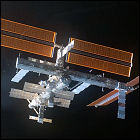 The three members of the Expedition 9 crew arrive on the International Space Station, and the station promptly loses one of its three gyroscopes, which keep the station aligned in orbit. According to NASA, the station can remain stable with only two of the gyroscopes operating, and even if a second one should fail, the thrusters of the newly-arrived Soyuz capsule can keep it aligned. Departing in their Soyuz vehicle will be Expedition 8 crewmembers Michael Foale and Alexander Kaleri, along with ESA astronaut Andrè Kuipers, who arrived with the Expedition 9 crew to perform a week’s worth of experiments. Manning the station for the next six months will be Commander Gennady Padalka and Flight Engineer Mike Fincke.
The three members of the Expedition 9 crew arrive on the International Space Station, and the station promptly loses one of its three gyroscopes, which keep the station aligned in orbit. According to NASA, the station can remain stable with only two of the gyroscopes operating, and even if a second one should fail, the thrusters of the newly-arrived Soyuz capsule can keep it aligned. Departing in their Soyuz vehicle will be Expedition 8 crewmembers Michael Foale and Alexander Kaleri, along with ESA astronaut Andrè Kuipers, who arrived with the Expedition 9 crew to perform a week’s worth of experiments. Manning the station for the next six months will be Commander Gennady Padalka and Flight Engineer Mike Fincke.
Soyuz TMA-4 / ISS Expedition 9
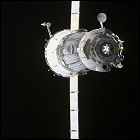 The ninth full-time crew of the International Space Station lifts off from Russia’s Baikonur Cosmodrome aboard Soyuz TMA-4. Gennady Padalka and Michael Fincke take up residence on the ISS for 187 days. Arriving with them on the ISS for a ten-day stay is Dutch astronaut Andre Kuipers, who returns to Earth aboard Soyuz TMA-3 with the Expedition 8 crew.
The ninth full-time crew of the International Space Station lifts off from Russia’s Baikonur Cosmodrome aboard Soyuz TMA-4. Gennady Padalka and Michael Fincke take up residence on the ISS for 187 days. Arriving with them on the ISS for a ten-day stay is Dutch astronaut Andre Kuipers, who returns to Earth aboard Soyuz TMA-3 with the Expedition 8 crew.
Light This Candle: The Life & Times of Alan Shepard
 Crown Books posthumously publishes Neal Thompson’s non-fictional biography, “Light This Candle: The Life & Times of Alan Shepard“, chronicling the life and career of Alan B. Shepard, the first of the Mercury astronauts to reach space, and the only veteran of the Mercury program to later walk on the moon despite medical issues that nearly ended his spaceflight career.
Crown Books posthumously publishes Neal Thompson’s non-fictional biography, “Light This Candle: The Life & Times of Alan Shepard“, chronicling the life and career of Alan B. Shepard, the first of the Mercury astronauts to reach space, and the only veteran of the Mercury program to later walk on the moon despite medical issues that nearly ended his spaceflight career.
We Have Capture: Tom Stafford and the Space Race
 Smithsonian Books publishes General Thomas Stafford’s non-fictional memoir of his time in NASA, “We Have Capture: Tom Stafford and the Space Race“, co-written with Michael Cassutt. The book details Stafford’s involvement in several NASA missions, from the Gemini program through the high-profile flights of Apollo 10 to the moon and the international Apollo-Soyuz Test Project mission.
Smithsonian Books publishes General Thomas Stafford’s non-fictional memoir of his time in NASA, “We Have Capture: Tom Stafford and the Space Race“, co-written with Michael Cassutt. The book details Stafford’s involvement in several NASA missions, from the Gemini program through the high-profile flights of Apollo 10 to the moon and the international Apollo-Soyuz Test Project mission.
Soyuz TMA-3 / ISS Expedition 8
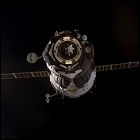 The eighth full-time crew of the International Space Station lifts off from Russia’s Baikonur Cosmodrome aboard Soyuz TMA-3. Alexander Kaleri and Michael Foale take up residence on the ISS for 194 days, both of them veterans of long-term stays aboard the Mir space station; arriving on the ISS with them for a ten-day stay is Spanish astronaut Pedro Duque, who returns to Earth aboard Soyuz TMA-2 with the Expedition 7 crew.
The eighth full-time crew of the International Space Station lifts off from Russia’s Baikonur Cosmodrome aboard Soyuz TMA-3. Alexander Kaleri and Michael Foale take up residence on the ISS for 194 days, both of them veterans of long-term stays aboard the Mir space station; arriving on the ISS with them for a ten-day stay is Spanish astronaut Pedro Duque, who returns to Earth aboard Soyuz TMA-2 with the Expedition 7 crew.
Shenzhou 5
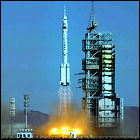 China becomes the third country to independently launch a crewed mission with the flight of Shenzhou 5, an orbital flight lasting almost 22 hours. Taikonaut Yang Liwei becomes the first Chinese citizen to leave Earth, though an American astronaut born in China had flown aboard space shuttle Challenger in 1985. Derived from Soviet-era Soyuz spacecraft, Shenzhou 5 comes in for a rough landing, causing Liwei some minor injuries upon impact.
China becomes the third country to independently launch a crewed mission with the flight of Shenzhou 5, an orbital flight lasting almost 22 hours. Taikonaut Yang Liwei becomes the first Chinese citizen to leave Earth, though an American astronaut born in China had flown aboard space shuttle Challenger in 1985. Derived from Soviet-era Soyuz spacecraft, Shenzhou 5 comes in for a rough landing, causing Liwei some minor injuries upon impact.
Apollo rides again?
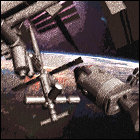 Last flown in the 1975 Apollo-Soyuz mission, the Apollo command/service module is – briefly – given strong consideration by NASA to serve as a “lifeboat” for the crew of the International Space Station, even to the point of conducting a study about un-mothballing the surviving unused Apollo hardware sitting in museums around the world. Part of the reason for this unusual study is that NASA’s budget has run out for finding a workable solution to keeping a “lifeboat” available to station astronauts in the anticipated long gap before the Space Shuttle’s return to service. Ultimately, even the seemingly unthinkable return of Apollo is nixed, since at least a Saturn IB booster would need to be similarly refitted – at huge expense – to lift a 30-year-old Apollo capsule into space.
Last flown in the 1975 Apollo-Soyuz mission, the Apollo command/service module is – briefly – given strong consideration by NASA to serve as a “lifeboat” for the crew of the International Space Station, even to the point of conducting a study about un-mothballing the surviving unused Apollo hardware sitting in museums around the world. Part of the reason for this unusual study is that NASA’s budget has run out for finding a workable solution to keeping a “lifeboat” available to station astronauts in the anticipated long gap before the Space Shuttle’s return to service. Ultimately, even the seemingly unthinkable return of Apollo is nixed, since at least a Saturn IB booster would need to be similarly refitted – at huge expense – to lift a 30-year-old Apollo capsule into space.
Soyuz TMA-2 / ISS Expedition 7
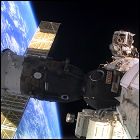 The seventh full-time crew of the International Space Station lifts off from Russia aboard Soyuz TMA-2, a drastic change from their original mission plan. Originally planned to be another short-term “ferry flight” to swap out the station’s Soyuz lifeboat vehicle, Soyuz became the only way to send full-time crews to the station during the post-Columbia-disaster grounding of the American shuttle fleet. Yuri Malenchenko and Ed Lu took up residence aboard the ISS for 184 days, returning in October 2003 with Spanish astronaut Pedro Duque. With the shuttle fleet landlocked, two-man ISS crews became the norm, as three-man crews relied on the greater resupply capacity of the shuttles.
The seventh full-time crew of the International Space Station lifts off from Russia aboard Soyuz TMA-2, a drastic change from their original mission plan. Originally planned to be another short-term “ferry flight” to swap out the station’s Soyuz lifeboat vehicle, Soyuz became the only way to send full-time crews to the station during the post-Columbia-disaster grounding of the American shuttle fleet. Yuri Malenchenko and Ed Lu took up residence aboard the ISS for 184 days, returning in October 2003 with Spanish astronaut Pedro Duque. With the shuttle fleet landlocked, two-man ISS crews became the norm, as three-man crews relied on the greater resupply capacity of the shuttles.
STS-107: Columbia down
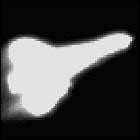 After nearly 17 days in orbit performing experiments in the SPACEHAB module its cargo bay, Space Shuttle Columbia deorbits to return to Earth for a planned landing at Kennedy Space Center in Florida. During reentry, a gaping hole in the leading edge of Columbia’s left wing – damage caused by a piece of foam shaken loose from the external fuel tank during liftoff – allows superheated plasma to leak into the shuttle’s superstructure, tearing the vehicle apart. The entire crew (Commander Rick Husband, Pilot Willie McCool, Payload Commander Michael Anderson, mission specialists Kalpana Chawla, David Brown and Laurel Clark, and payload specialist Ilan Ramon) is lost. At first, ground controllers are only aware of a series of sensor failures in the wing, followed by a loss of contact; ground-based cameras finally spot an expanding cloud of debris falling at supersonic speeds. As with the loss of Challenger in 1986, an extensive investigation and review of NASA procedures follows the loss of Columbia and her crew, resulting in a two-year grounding of the remaining shuttle fleet and a pause in construction of the International Space Station.
After nearly 17 days in orbit performing experiments in the SPACEHAB module its cargo bay, Space Shuttle Columbia deorbits to return to Earth for a planned landing at Kennedy Space Center in Florida. During reentry, a gaping hole in the leading edge of Columbia’s left wing – damage caused by a piece of foam shaken loose from the external fuel tank during liftoff – allows superheated plasma to leak into the shuttle’s superstructure, tearing the vehicle apart. The entire crew (Commander Rick Husband, Pilot Willie McCool, Payload Commander Michael Anderson, mission specialists Kalpana Chawla, David Brown and Laurel Clark, and payload specialist Ilan Ramon) is lost. At first, ground controllers are only aware of a series of sensor failures in the wing, followed by a loss of contact; ground-based cameras finally spot an expanding cloud of debris falling at supersonic speeds. As with the loss of Challenger in 1986, an extensive investigation and review of NASA procedures follows the loss of Columbia and her crew, resulting in a two-year grounding of the remaining shuttle fleet and a pause in construction of the International Space Station.
STS-107
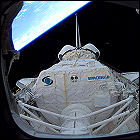 Space Shuttle Columbia lifts off for a scientific research mission with the SPACEHAB module – a successor to Spacelab – in its cargo bay, for a flight lasting almost 17 days. Columbia’s crew for this flight is Commander Rick Husband, Pilot Willie McCool, Payload Commander Michael Anderson, mission specialists Kalpana Chawla, David Brown and Laurel Clark, and payload specialist Ilan Ramon, the first Israeli astronaut. During liftoff, a piece of insulated foam is vibrated loose from the shuttle’s external fuel tank, causing critical damage to the leading edge of Columbia’s left wing. The foam collision is noticed and discussed internally at NASA, but is not deemed a threat by ground controllers.
Space Shuttle Columbia lifts off for a scientific research mission with the SPACEHAB module – a successor to Spacelab – in its cargo bay, for a flight lasting almost 17 days. Columbia’s crew for this flight is Commander Rick Husband, Pilot Willie McCool, Payload Commander Michael Anderson, mission specialists Kalpana Chawla, David Brown and Laurel Clark, and payload specialist Ilan Ramon, the first Israeli astronaut. During liftoff, a piece of insulated foam is vibrated loose from the shuttle’s external fuel tank, causing critical damage to the leading edge of Columbia’s left wing. The foam collision is noticed and discussed internally at NASA, but is not deemed a threat by ground controllers.
STS-113 / ISS Expedition 6
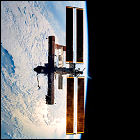 Space Shuttle Endeavour lifts off on the 112th shuttle flight, a two-week mission to resupply and exchange crews at the International Space Station. Another structural tress to dissipate excess heat into space is assembled and attached. Aboard Endeavour for her 19th flight are Commander James Wetherbee, Pilot Paul Lockhart, mission specialists Michael Lopez-Alegria and John Herrington, and ISS Expedition 6 crewmembers Kenneth Bowersox, Nikolai Budarin and Don Pettit. Returning to Earth aboard the shuttle are Expedition 5 crewmembers Valeri Korzun, Peggy Whitson and Sergei Treschev.
Space Shuttle Endeavour lifts off on the 112th shuttle flight, a two-week mission to resupply and exchange crews at the International Space Station. Another structural tress to dissipate excess heat into space is assembled and attached. Aboard Endeavour for her 19th flight are Commander James Wetherbee, Pilot Paul Lockhart, mission specialists Michael Lopez-Alegria and John Herrington, and ISS Expedition 6 crewmembers Kenneth Bowersox, Nikolai Budarin and Don Pettit. Returning to Earth aboard the shuttle are Expedition 5 crewmembers Valeri Korzun, Peggy Whitson and Sergei Treschev.
This is the last successful shuttle mission for over two years.
Soyuz TMA-1: the only ride in town
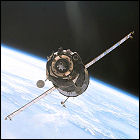 Russia launches a new variant of the venerable Soyuz spacecraft, Soyuz TMA-1, on a mission to the International Space Station. Cosmonauts Sergei Zalyotin and Yury Lonchakov and Belgian astronaut
Russia launches a new variant of the venerable Soyuz spacecraft, Soyuz TMA-1, on a mission to the International Space Station. Cosmonauts Sergei Zalyotin and Yury Lonchakov and Belgian astronaut
Frank De Winne visit the ISS for 11 days, conducting experiments and bringing supplies to the station. This crew returns to Earth aboard Soyuz TM-34, leaving Soyuz TMA-1 at the ISS. When the space shuttle fleet is grounded early in 2003 after the Columbia disaster, Soyuz TMA-1, still berthed at the ISS, becomes the only ride home for the station’s sixth full-time crew.
STS-112
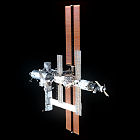 Space Shuttle Atlantis lifts off on the 111th shuttle flight, an 11-day construction mission to the International Space Station. Another major structural truss is assembled and attached, serving the primary function of radiating built-up waste heat away from the station and into space. Aboard Atlantis for her 26th flight are Commander Jeff Ashby, Pilot Pamela Melroy, and mission specialists David Wolf, Piers Sellers, Sandra Magnus and Fyodor Yurchikhin.
Space Shuttle Atlantis lifts off on the 111th shuttle flight, an 11-day construction mission to the International Space Station. Another major structural truss is assembled and attached, serving the primary function of radiating built-up waste heat away from the station and into space. Aboard Atlantis for her 26th flight are Commander Jeff Ashby, Pilot Pamela Melroy, and mission specialists David Wolf, Piers Sellers, Sandra Magnus and Fyodor Yurchikhin.
One giant can of whoop-ass for mankind
 As Apollo 11 astronaut Buzz Aldrin leaves a speaking engagement in Beverly Hills, a self-proclaimed skeptic accosts him, demanding that the astronaut swear on the Bible that he actually went to the moon. With a Japanese news crew’s cameras rolling, Aldrin proceeds to punch the man in the face. The heckler and self-proclaimed “ambush journalist” tries to file assault charges, though police decide in Aldrin’s favor – especially since this is the third time the man has ambushed Aldrin with his theory that all of the Apollo flights to the moon were hoaxes.
As Apollo 11 astronaut Buzz Aldrin leaves a speaking engagement in Beverly Hills, a self-proclaimed skeptic accosts him, demanding that the astronaut swear on the Bible that he actually went to the moon. With a Japanese news crew’s cameras rolling, Aldrin proceeds to punch the man in the face. The heckler and self-proclaimed “ambush journalist” tries to file assault charges, though police decide in Aldrin’s favor – especially since this is the third time the man has ambushed Aldrin with his theory that all of the Apollo flights to the moon were hoaxes.
STS-111 / ISS Expedition 5
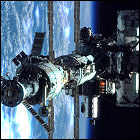 Space Shuttle Endeavour lifts off on the 110th shuttle flight, a mission to exchange the crew of the International Space Station. Scheduled supplies and other equipment are also transported to the station. Aboard Endeavour for her 18th flight are Commander Kenneth Cockrell, Pilot Paul Lockhart, mission specialists Franklin Chang-Diaz and Philippe Perrin, and ISS Expedition 5 crewmembers Valeri Korzun, Peggy Whitson and Sergei Treschev. Returning to Earth aboard the shuttle are ISS Expedition 4 crewmembers Yuri Onufriyenko, Carl Walz and Daniel Bursch.
Space Shuttle Endeavour lifts off on the 110th shuttle flight, a mission to exchange the crew of the International Space Station. Scheduled supplies and other equipment are also transported to the station. Aboard Endeavour for her 18th flight are Commander Kenneth Cockrell, Pilot Paul Lockhart, mission specialists Franklin Chang-Diaz and Philippe Perrin, and ISS Expedition 5 crewmembers Valeri Korzun, Peggy Whitson and Sergei Treschev. Returning to Earth aboard the shuttle are ISS Expedition 4 crewmembers Yuri Onufriyenko, Carl Walz and Daniel Bursch.
Buran buried
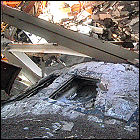 Stored in a hangar undergoing structural work at the Baikonur Cosmodrome in Kazakhstan, the Soviet-era Space Shuttle Buran is destroyed when that building collapses, an incident that also costs the lives of several workers at the site. Russian space officials deny that poor maintenance is an issue at the site; the Buran shuttle, the only Soviet shuttle to reach space, is damaged beyond repair.
Stored in a hangar undergoing structural work at the Baikonur Cosmodrome in Kazakhstan, the Soviet-era Space Shuttle Buran is destroyed when that building collapses, an incident that also costs the lives of several workers at the site. Russian space officials deny that poor maintenance is an issue at the site; the Buran shuttle, the only Soviet shuttle to reach space, is damaged beyond repair.
Soyuz TM-34
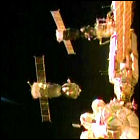 Russia launches a short-term visiting crew to the International Space Station aboard Soyuz TM-34. This is the last Soyuz TM class vehicle to fly, with a newer version of the capsule, Soyuz TMA, scheduled to launch later in 2002. Russian cosmonaut Yuri Gidzenko, Italian astronaut Roberto Vittori, and South African space tourist Mark Shuttleworth comprise Soyuz TM-34’s crew, staying at the ISS for eight days. Like Dennis Tito before him, multi-millionaire and Linux developer Shuttleworth has paid for his own ride into space. This crew leaves the Soyuz TM-34 vehicle at the ISS, returning home aboard Soyuz TM-33.
Russia launches a short-term visiting crew to the International Space Station aboard Soyuz TM-34. This is the last Soyuz TM class vehicle to fly, with a newer version of the capsule, Soyuz TMA, scheduled to launch later in 2002. Russian cosmonaut Yuri Gidzenko, Italian astronaut Roberto Vittori, and South African space tourist Mark Shuttleworth comprise Soyuz TM-34’s crew, staying at the ISS for eight days. Like Dennis Tito before him, multi-millionaire and Linux developer Shuttleworth has paid for his own ride into space. This crew leaves the Soyuz TM-34 vehicle at the ISS, returning home aboard Soyuz TM-33.
STS-110: giving ISS its backbone
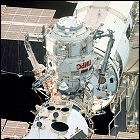 Space Shuttle Atlantis lifts off on the 109th shuttle flight, an 11-day mission to add the integrated truss “backbone” to the International Space Station. In addition to assembling and attaching this major part of the station, a mobile transport is added for the station’s remote manipulator arm, allowing the arm to roll from one end of the station to the other for whatever functions may be required. Aboard Atlantis for her 25th flight are Commander Michael Bloomfield, Pilot Stephen Frick, and mission specialists Jerry Ross, Steven Smith, Ellen Ochoa, Lee Morin and Rex Walheim.
Space Shuttle Atlantis lifts off on the 109th shuttle flight, an 11-day mission to add the integrated truss “backbone” to the International Space Station. In addition to assembling and attaching this major part of the station, a mobile transport is added for the station’s remote manipulator arm, allowing the arm to roll from one end of the station to the other for whatever functions may be required. Aboard Atlantis for her 25th flight are Commander Michael Bloomfield, Pilot Stephen Frick, and mission specialists Jerry Ross, Steven Smith, Ellen Ochoa, Lee Morin and Rex Walheim.
STS-109: Hubble’s new wings
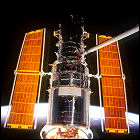 Space Shuttle Columbia lifts off on the 108th shuttle flight, the third Hubble Space Telescope servicing mission. Numerous enhancements are carried aboard the shuttle to replace existing parts on the decade-old orbiting telescope, including new cooling systems and a new set of solar power arrays. Aboard Columbia for her 27th flight are Commander Scott Altman, Pilot Duane Carey, Payload Commander John Grunsfeld, and mission specialists Nancy Currie, James Newman, Richard Linnehan and Michael Massimino.
Space Shuttle Columbia lifts off on the 108th shuttle flight, the third Hubble Space Telescope servicing mission. Numerous enhancements are carried aboard the shuttle to replace existing parts on the decade-old orbiting telescope, including new cooling systems and a new set of solar power arrays. Aboard Columbia for her 27th flight are Commander Scott Altman, Pilot Duane Carey, Payload Commander John Grunsfeld, and mission specialists Nancy Currie, James Newman, Richard Linnehan and Michael Massimino.
Space Shuttle Columbia makes her final landing at the end of this 11-day mission.
STS-108 / ISS Expedition 4
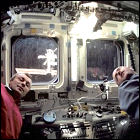 Space Shuttle Endeavour lifts off on the 107th shuttle flight, a resupply and crew rotation mission to the International Space Station. Aboard Endeavour for her 17th flight are Commander Dominic Gorie, Pilot Mark Kelly, mission specialists Linda Godwin and Daniel Tani, and ISS Expedition 4 crewmembers Yuri Onufrienko, Carl Walz and Daniel Bursch. Returning to Earth via Endeavour are ISS Expedition 3 crewmembers Frank Culbertson, Mikhail Turin and Vladimir Dezhurov.
Space Shuttle Endeavour lifts off on the 107th shuttle flight, a resupply and crew rotation mission to the International Space Station. Aboard Endeavour for her 17th flight are Commander Dominic Gorie, Pilot Mark Kelly, mission specialists Linda Godwin and Daniel Tani, and ISS Expedition 4 crewmembers Yuri Onufrienko, Carl Walz and Daniel Bursch. Returning to Earth via Endeavour are ISS Expedition 3 crewmembers Frank Culbertson, Mikhail Turin and Vladimir Dezhurov.
Soyuz TM-33
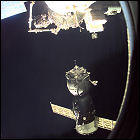 Russia launches Soyuz TM-33 on a mission to the International Space Station. Aboard the Soyuz are cosmonauts Viktor Afanasyev and Konstantin Kozeyev, and French spationaut Claudie Haigneré, making her second visit to a space station (she has previously visited Russia’s Mir space station). This is a short-term visiting crew, spending only eight days aboard Mir and then returning aboard the older Soyuz TM-32 spacecraft, leaving TM-33 as the return vehicle for the next visiting crew.
Russia launches Soyuz TM-33 on a mission to the International Space Station. Aboard the Soyuz are cosmonauts Viktor Afanasyev and Konstantin Kozeyev, and French spationaut Claudie Haigneré, making her second visit to a space station (she has previously visited Russia’s Mir space station). This is a short-term visiting crew, spending only eight days aboard Mir and then returning aboard the older Soyuz TM-32 spacecraft, leaving TM-33 as the return vehicle for the next visiting crew.
ISS: Pirs module launched
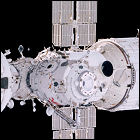 Russia launches the Pirs docking module into orbit, where automatic systems allow it to rendezvous with the International Space Station for docking to the existing Zvezda module. The Pirs module adds a docking port for Soyuz capsules, as well as an airlock for future spacewalks.
Russia launches the Pirs docking module into orbit, where automatic systems allow it to rendezvous with the International Space Station for docking to the existing Zvezda module. The Pirs module adds a docking port for Soyuz capsules, as well as an airlock for future spacewalks.
STS-105 / ISS Expedition 3
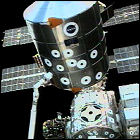 Space Shuttle Discovery lifts off on the 106th shuttle flight, a mission to exchange crews aboard the International Space Station. The shuttle’s cargo bay carries a logistics module containing more equipment for the ISS laboratory module, as well as storage racks to be installed elsewhere in the station. Aboard Discovery for her 30th flight are Commander Scott Horowitz, Pilot Frederick Sturckow, missions specialists Daniel Barry and Patrick Forrester, and ISS Expedition 3 crewmembers Frank Culbertson, Mikhail Turin and Vladimir Dezhurov, who remain aboard the station. Returning to Earth via Discovery are ISS Expedition 2 crewmembers Yury Usachev, James Voss and Susan Helms.
Space Shuttle Discovery lifts off on the 106th shuttle flight, a mission to exchange crews aboard the International Space Station. The shuttle’s cargo bay carries a logistics module containing more equipment for the ISS laboratory module, as well as storage racks to be installed elsewhere in the station. Aboard Discovery for her 30th flight are Commander Scott Horowitz, Pilot Frederick Sturckow, missions specialists Daniel Barry and Patrick Forrester, and ISS Expedition 3 crewmembers Frank Culbertson, Mikhail Turin and Vladimir Dezhurov, who remain aboard the station. Returning to Earth via Discovery are ISS Expedition 2 crewmembers Yury Usachev, James Voss and Susan Helms.
STS-104
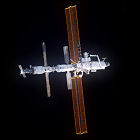 Space Shuttle Atlantis lifts off on the 105th shuttle flight, a 13-day flight to resupply and install new hardware on the International Space Station. The station gains a new airlock and an equipment pallet – formerly part of the Spacelab module – which is attached to the station’s exterior. Aboard Atlantis for her 24th flight are Commander Steven Lindsey, Pilot Charles Hobaugh, and mission specialists Michael Gernhardt, James Reilly and Janet Kavandi.
Space Shuttle Atlantis lifts off on the 105th shuttle flight, a 13-day flight to resupply and install new hardware on the International Space Station. The station gains a new airlock and an equipment pallet – formerly part of the Spacelab module – which is attached to the station’s exterior. Aboard Atlantis for her 24th flight are Commander Steven Lindsey, Pilot Charles Hobaugh, and mission specialists Michael Gernhardt, James Reilly and Janet Kavandi.
Soyuz TM-32: tourism in space
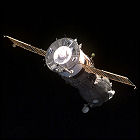 Russia launches Soyuz TM-32 to the International Space Station. Aboard the Soyuz for an eight-day stay on the ISS are cosmonauts Talgat Musabayev and Yuri Baturin, and multi-millionaire space tourist Dennis Tito, the first space traveler to buy his own seat aboard a spacecraft. NASA is less than thrilled with the presence of a “tourist” in space, and refuses to allow Tito to train in advance for activities in the American-built segments of the station. This crew returns to Earth aboard Soyuz TM-31.
Russia launches Soyuz TM-32 to the International Space Station. Aboard the Soyuz for an eight-day stay on the ISS are cosmonauts Talgat Musabayev and Yuri Baturin, and multi-millionaire space tourist Dennis Tito, the first space traveler to buy his own seat aboard a spacecraft. NASA is less than thrilled with the presence of a “tourist” in space, and refuses to allow Tito to train in advance for activities in the American-built segments of the station. This crew returns to Earth aboard Soyuz TM-31.
STS-100: fully armed & operational station
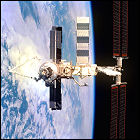 Space Shuttle Endeavour lifts off on the 104th shuttle flight, a 12-day mission to resupply and continue construction of the International Space Station. The primary addition to the station is the Canadian-built remote manipulator arm, derived from the design that has been flown throughout the Space Shuttle program, to be affixed to the station itself. Aboard Endeavour for her 16th flight are Commander Kent Rominger, Pilot Jeff Ashby, and mission specialists Chris Hadfield, Scott Parazynski, John Phillips, Umberto Guidoni and Yuri Lonchakov.
Space Shuttle Endeavour lifts off on the 104th shuttle flight, a 12-day mission to resupply and continue construction of the International Space Station. The primary addition to the station is the Canadian-built remote manipulator arm, derived from the design that has been flown throughout the Space Shuttle program, to be affixed to the station itself. Aboard Endeavour for her 16th flight are Commander Kent Rominger, Pilot Jeff Ashby, and mission specialists Chris Hadfield, Scott Parazynski, John Phillips, Umberto Guidoni and Yuri Lonchakov.
Mir death experience
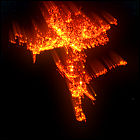 Despite attempts in recent years to keep the station in orbit for commercial purposes, the Russian space station Mir – originally launched in 1986 by the Soviet Union – is brought out of orbit with a deorbit burn fired by the engines of an attached unmanned Progress cargo vehicle. The largest space vehicle ever to plunge through Earth’s atmosphere, Mir breaks up over the south Pacific, where any surviving debris is expected to sink harmlessly into the ocean east of New Zealand. The fifteen-year-old station, having been designed with a service life of five years in mind, had been the site of the first joint Russian-American manned space operations since 1975, and led directly to both the contractual agreements and design of the International Space Station.
Despite attempts in recent years to keep the station in orbit for commercial purposes, the Russian space station Mir – originally launched in 1986 by the Soviet Union – is brought out of orbit with a deorbit burn fired by the engines of an attached unmanned Progress cargo vehicle. The largest space vehicle ever to plunge through Earth’s atmosphere, Mir breaks up over the south Pacific, where any surviving debris is expected to sink harmlessly into the ocean east of New Zealand. The fifteen-year-old station, having been designed with a service life of five years in mind, had been the site of the first joint Russian-American manned space operations since 1975, and led directly to both the contractual agreements and design of the International Space Station.
STS-102 / ISS Expedition 2
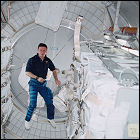 Space Shuttle Discovery lifts off on the 103rd shuttle flight, a mission to exchange crewmembers aboard the International Space Station. In the cargo bay is a logistics module containing consumables, supplies, and equipment racks to be installed in the Destiny laboratory module. Aboard Discovery for her 29th flight are Commander James Wetherbee, Pilot James Kelly, mission specialists Andrew Thomas and Paul Richards, and ISS Expedition 2 crewmembers James Voss, Susan Helms and Yuriy Usachev. The Expedition 1 crewmembers (William Shepherd, Yuri Gidzenko and Sergei Krikalev) return to Earth aboard the shuttle.
Space Shuttle Discovery lifts off on the 103rd shuttle flight, a mission to exchange crewmembers aboard the International Space Station. In the cargo bay is a logistics module containing consumables, supplies, and equipment racks to be installed in the Destiny laboratory module. Aboard Discovery for her 29th flight are Commander James Wetherbee, Pilot James Kelly, mission specialists Andrew Thomas and Paul Richards, and ISS Expedition 2 crewmembers James Voss, Susan Helms and Yuriy Usachev. The Expedition 1 crewmembers (William Shepherd, Yuri Gidzenko and Sergei Krikalev) return to Earth aboard the shuttle.
STS-98: fulfilling Destiny
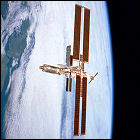 Space Shuttle Atlantis lifts off on the 102nd shuttle flight, a mission to install the American-made Destiny laboratory module on the International Space Station. Once attached to its connection point on the Unity module, Destiny is powered up and pressurized, adding more space for scientific experiments to the station. Aboard Atlantis for her 22nd flight are Commander Kenneth Cockrell, Pilot Mark Polansky, and mission specialists Robert Curbeam, Thomas Jones and Marsha Ivins.
Space Shuttle Atlantis lifts off on the 102nd shuttle flight, a mission to install the American-made Destiny laboratory module on the International Space Station. Once attached to its connection point on the Unity module, Destiny is powered up and pressurized, adding more space for scientific experiments to the station. Aboard Atlantis for her 22nd flight are Commander Kenneth Cockrell, Pilot Mark Polansky, and mission specialists Robert Curbeam, Thomas Jones and Marsha Ivins.
STS-97: increase the power!
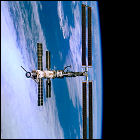 Space Shuttle Endeavour lifts off on an 11-day mission to add a major solar power array to the International Space Station. For the first time, a crew has already arrived via Soyuz and taken up residence on the station prior to the shuttle’s arrival. Another external truss is added, and the first large solar power array – 240 feet long – is added to it, more than quintupling the power available aboard the station. Aboard Endeavour for her 15th flight are Commander Brent Jett, Pilot Michael Bloomfield, and mission specialists Joseph Tanner, Marc Garneau and Carlos Noriega.
Space Shuttle Endeavour lifts off on an 11-day mission to add a major solar power array to the International Space Station. For the first time, a crew has already arrived via Soyuz and taken up residence on the station prior to the shuttle’s arrival. Another external truss is added, and the first large solar power array – 240 feet long – is added to it, more than quintupling the power available aboard the station. Aboard Endeavour for her 15th flight are Commander Brent Jett, Pilot Michael Bloomfield, and mission specialists Joseph Tanner, Marc Garneau and Carlos Noriega.